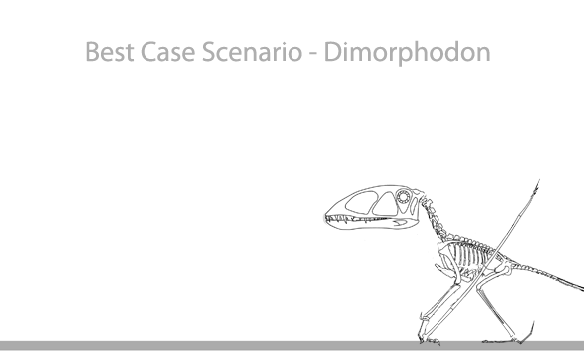Earlier I produced an animated GIF that showed how Dimorphodon could not have taken off using its forelimbs (Fig. 1; contra Witton 2013). At the same time I produced an animated GIF that showed how Dimorphodon could have taken off using its hind limbs

Figure 3. Dimorphodon and Desmodus (the vampire bat) compared in size. It’s more difficult for larger, heavier creatures to leap, as the mass increases by the cube of the height. Size matters. And yes the tail attributed to Dinmorphodon, though not associated with the rest of the skeleton, was that long. Note the toes fall directly beneath the center of balance, the shoulder glenoid, on this pterosaur, And it would have been awkward to get down on all fours.
with wings still folded (modified Fig. 2), noting that back then I preferred to use the wings, but wanted to show how powerful the hind limbs were. For some reason I waited until today to offer an animated GIF in which the wings open prior to takeoff and together with the hind limbs initiate a power launch with maximum thrust (Fig. 3), just like birds.

Figure 1. Click to animate. Witton’s Dimorphodon in the process of leaping. Note the wings are in the upswing at the apex of the leap. The opposite and equal reaction, along with gravity, pushes the pterosaur down. There’s just not as much leverage and musculature here as in the vampire bat, which can accomplish this leap.

Figure 2, 3. Dimorphodon take off (with the new small tail).
Which takeoff method is less risky? Uses larger muscle groups? Is replicated by living taxa? And falls in line with basal nonvolent taxa (like Sharovipteryx and Longisquama)? Why not use the wing thrust to ensure getting airborne? That’s what birds and bats do…
And why are paleontologists embracing this heretical idea and giving it the status of paradigm? Now the ‘normal’ takeoff, like a bird, is considered heretical.

Figure 4. Dimorphodon fingers. Yellow added for keratin extensions. M. Witton suggests that these claws are inappropriate for grasping and so doesn’t mind placing Dimorphodon into a quadrupedal pose, making everything awkward to impossible from that point on. These claws look trenchant to me, ideal for clinging to tree bark or other similar substrates.
Today’s blog post was inspired
by one produced by Dr. M. Witton in response to the Jurassic World movie, who noted, “The hands and feet of Dimorphodon are also robust, and equipped with large, trenchant claw bones (these, of course, provide the specific namesake, ‘macronyx’). There are indications that the extensor muscles controlling these might have been powerful, as every claw on both hands and feet is equipped with a neighbouring sesamoid – those intra-tendinous bones serving to enhance muscle output or protect tendons against powerful joint motion. Interestingly, the only other animals with these claw-adjacent sesamoids are lizards and a ‘bottom walking’ fossil stem-turtle – more on that another time. As with all pterosaurs, there is no indication that their hands or feet were for grasping, and their claws are really nothing like talons (take that, Jurassic World website).”
If I’m reading this correctly
Dr. Witton doesn’t consider ‘trenchant’ (= penetrating) claw bones to be anything like ‘talons,’ which typically are unguals that penetrate prey. The feet of pterosaurs are indeed not made for grasping (screaming tourists, etc.), but the wing claws of Dimorphodon were ideally set up for vertical landings on tree trunks. When the wings are adducted the palmar side of the unguals face each other like clapping hands and could have readily grappled a tree trunk like a lineman, penetrating the bark with its talons. This is taken to the extreme in the related pterosaur, Jeholopterus and the bird-like dinosaur, Velociraptor, which had similar stiff fingers supporting feathers and trenchant claws – ideal for grappling, but not grasping.
Earlier we looked at
pterosaur hands here in the first of a seven-part series. The variety you’ll see will show you that pterosaur fingers and claws evolved for several environments and uses.
References
Witton M. 2013. Pterosaurs. Princeton University Press. 291 pages.

spell-checker alert: nonvolant, not nonviolent in second text paragraph
Thank you. WordPress is notorious for those.